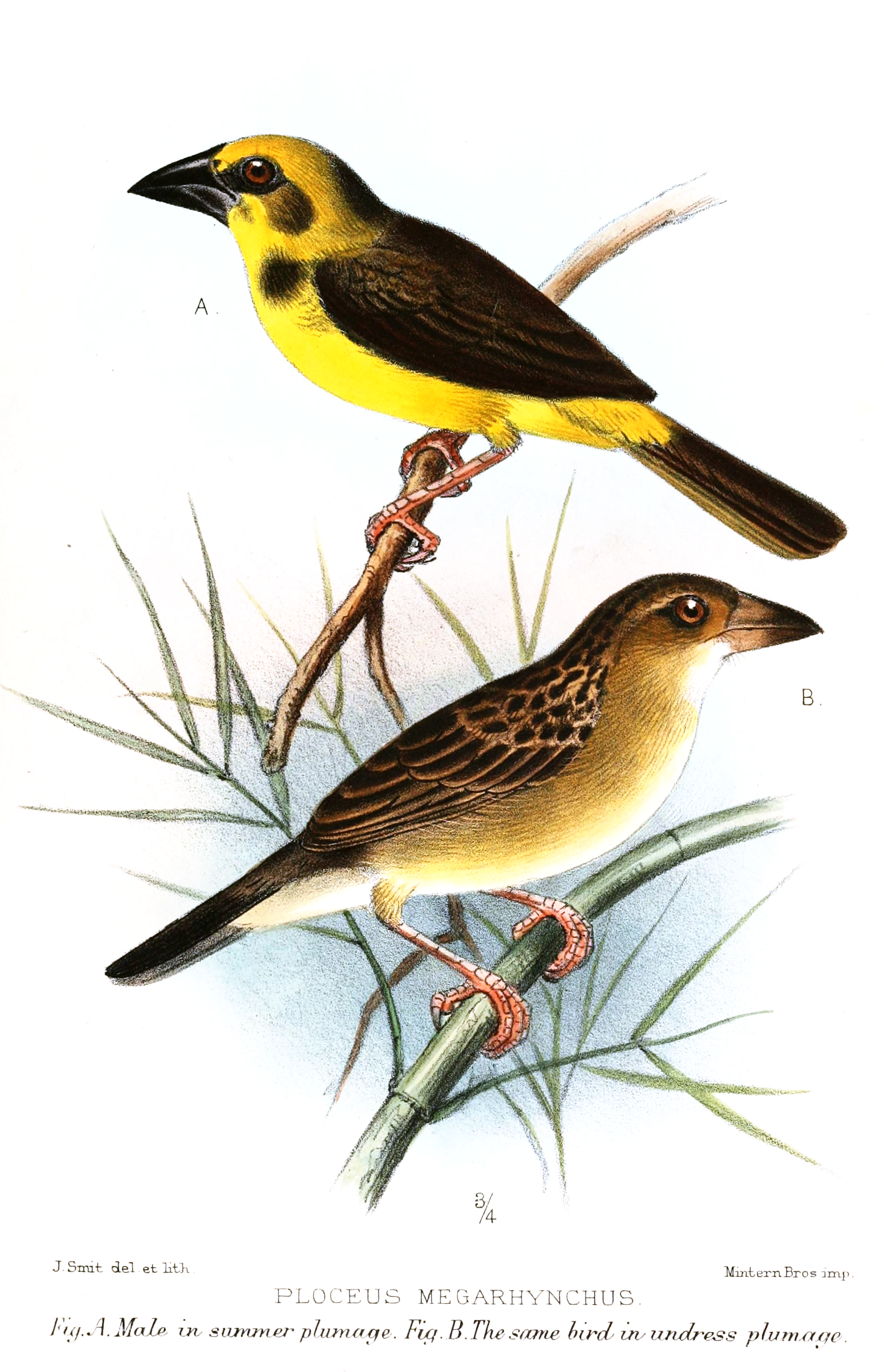Finn's Weaver on:
[Wikipedia]
[Google]
[Amazon]
Finn's weaver (''Ploceus megarhynchus''), also known as Finn's baya and yellow weaver is a
 The species was called "Eastern baya" by Oates in 1889 and called Finn's baya after Frank Finn by
The species was called "Eastern baya" by Oates in 1889 and called Finn's baya after Frank Finn by
BirdLife International: ''Yellow Weaver''
/ref> It builds a nest on top of trees or in reeds. The nest is different in structure from the other weaver species found in India, but as in other weavers, woven from thin strips of leaves and reeds. This species lines the entire inside of the nest, unlike the other weavers, which line only the floor of the nest. Males strip the leaves of the nest tree, making the globular nests clearly visible.
Finn's weaver
- Species text in Weaver Watch. {{Taxonbar, from=Q1314032 Finn's weaver Birds of India Birds of Nepal Birds of Northeast India Finn's weaver
weaver bird
Ploceidae is a family of small passerine birds, many of which are called weavers, weaverbirds, weaver finches and bishops. These names come from the nests of intricately woven vegetation created by birds in this family. In most recent classifi ...
species native to the Ganges and Brahmaputra valleys in India and Nepal. Two subspecies are known; the nominate subspecies
In biological classification, subspecies is a rank below species, used for populations that live in different areas and vary in size, shape, or other physical characteristics (morphology), but that can successfully interbreed. Not all species ...
occurs in the Kumaon area and ''salimalii'' in the eastern Terai.
The species was described and given its binomial name by Allan Octavian Hume based on a specimen obtained at Kaladhungi near Nainital.
Etymology
 The species was called "Eastern baya" by Oates in 1889 and called Finn's baya after Frank Finn by
The species was called "Eastern baya" by Oates in 1889 and called Finn's baya after Frank Finn by E. C. Stuart Baker
Edward Charles Stuart Baker CIE OBE FZS FLS (1864 – 16 April 1944) was a British ornithologist and police officer. He catalogued the birds of India and produced the second edition of the ''Fauna of British India'' which included the introd ...
in 1925.
Distribution and habitat
Finn's weaver was first observed in Shuklaphanta National Park in May 1996 and is a regular summer visitor.Behaviour and ecology
Finn's weaver breeds from May to September.BirdLife International (2009) Species factsheet: ''Ploceus megarhynchus''BirdLife International: ''Yellow Weaver''
/ref> It builds a nest on top of trees or in reeds. The nest is different in structure from the other weaver species found in India, but as in other weavers, woven from thin strips of leaves and reeds. This species lines the entire inside of the nest, unlike the other weavers, which line only the floor of the nest. Males strip the leaves of the nest tree, making the globular nests clearly visible.
References
Other references
* Abdulali, H. (1954) More notes on Finn's Baya (''Ploceus megarhynchus''). Journal of the Bombay Natural History 52(2&3): 599–601. * Abdulali, H. (1961) The nesting habits of the eastern race of Finn's Baya ''Ploceus megarhynchus salimalii'' (Abdulali). Journal of the Bombay Natural History 58(1): 269–270. * Ali, S. (1935) Mainly in quest of Finn's Baya. Indian Forester 41(6): 365–374. * Ali, S., Crook, J. H. (1959) Observations on Finn's Baya (''Ploceus megarhynchus'' Hume) rediscovered in the Kumaon terai, 1959.Journal of the Bombay Natural History 56(3): 457–483. * Ambedkar, V.C. (1968) Observations on the breeding biology of Finn's Baya (''Ploceus megarhynchus'' Hume) in the Kumaon Terai. Journal of the Bombay Natural History 65(3): 596–607. * Hart, W.C. (1937) Finn's Baya ''Ploceus megarhyncheus'' Hume). Indian Forester 43(1): 45–46. * O'Donell, H.V. (1916) The Eastern Baya ''Ploceus megarynchus'' nesting in the same tree as the Jungle Bee ''Apis indicus''. Journal of the Bombay Natural History 24(4): 821. * Rai, Y. M. (1979) Observations on Finn's Baya breeding near Meerut. '' Newsletter for Birdwatchers'' 19(11): 11. * Rai, Y.M. (1979) Finn's Baya breeding at Meerut. ''Newsletter for Birdwatchers'' 19(7): 11. * Rai, Y.M. (1983) Hastinapur birds: Finn's Baya; Tawny Eagle; Crested Honey-Buzzard. ''Newsletter for Birdwatchers'' 23(7-8): 14–15. * Saha, S.S. (1967) The Finn's Baya ''Ploceus megarhynchus'' Hume ves: Passeriformes: Ploceidaeand its breeding colony near Calcutta. Proc. Zoological Society Calcutta 20: 181–185. * Saha, S.S. (1976) Occurrence of Finn's Baya (''Ploceus megarhynchus'' Hume) in Darrang District, Assam. Journal of the Bombay Natural History 73(3): 527–529.External links
Finn's weaver
- Species text in Weaver Watch. {{Taxonbar, from=Q1314032 Finn's weaver Birds of India Birds of Nepal Birds of Northeast India Finn's weaver